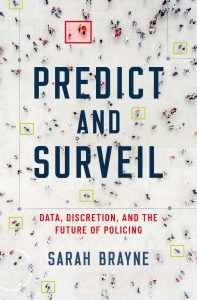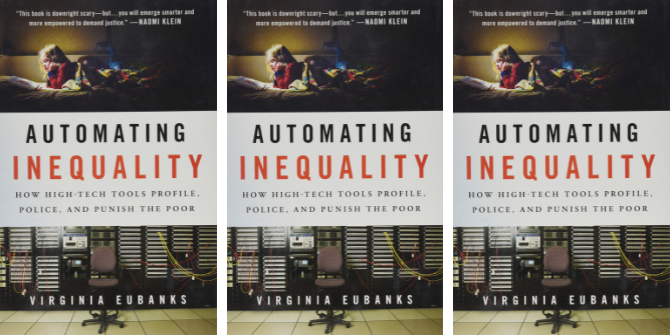In Predict and Surveil: Data, Discretion and the Future of Policing, Sarah Brayne looks at how the Los Angeles Police Department’s (LAPD) use of surveillance technology has changed its approach to policing and how police culture views the entrance of all this new technology. Grounded in ethnographic research and attentive observation, the book offers a useful example of social science methods examining closed-source proprietary algorithms and suggests many possible ways to reform police technology use, writes Sam di Bella.
Predict and Surveil: Data, Discretion and the Future of Policing. Sarah Brayne. Oxford University Press. 2020.
 Policing in the United States is at a breaking point. The past year of Black Lives Matter protests and legal rulings, like the recent Kentucky grand jury’s decision not to indict the Louisville police officers who killed Breonna Taylor, have continued to show that US policing is rarely held accountable for the harm it causes. And in an institution that exerts the state’s monopoly on violence, to lack legitimacy is a precarious position indeed. Sarah Brayne’s recently published monograph, Predict and Surveil, looks at how the Los Angeles Police Department’s (LAPD) use of surveillance technology has changed its approach to policing and how police culture views the entrance of all this new tech. A Professor in Sociology at University of Texas–Austin, Brayne uses ethnographic research and attentive observation to examine a culture that is notoriously taciturn.
Policing in the United States is at a breaking point. The past year of Black Lives Matter protests and legal rulings, like the recent Kentucky grand jury’s decision not to indict the Louisville police officers who killed Breonna Taylor, have continued to show that US policing is rarely held accountable for the harm it causes. And in an institution that exerts the state’s monopoly on violence, to lack legitimacy is a precarious position indeed. Sarah Brayne’s recently published monograph, Predict and Surveil, looks at how the Los Angeles Police Department’s (LAPD) use of surveillance technology has changed its approach to policing and how police culture views the entrance of all this new tech. A Professor in Sociology at University of Texas–Austin, Brayne uses ethnographic research and attentive observation to examine a culture that is notoriously taciturn.
A central argument in Predict and Surveil is that the collection of surveillance data is now viewed as an integral function of the LAPD, whether or not that data has a direct connection to crime. Brayne also rejects that mass surveillance is a necessary part of mass datafication. Rather, she argues, the LAPD’s technology is a reflection of societal choices about who and what is considered worthy of scrutiny. Furthermore, Brayne believes that large data sets can keep police accountable and help researchers examine cultural biases. The trick is understanding how the culture around technology causes it to be used in unintended ways (or when its intended use has unforeseen bias baked in). Citing Nick Seaver’s work on algorithmic culture, she describes the ‘whole chain’ of the LAPD’s technology use as ‘mired in discretionary choices’ (140).
Drawing from theories and methods in sociology, surveillance studies and criminology, Brayne unpicks the LAPD’s mixed methods of mass (also known as ‘dragnet’) and directed surveillance. Her results are grounded in an overview of surveillance technologies in twentieth-century policing and the US ‘scientific turn’ in policing methods. As a final flourish, Brayne discusses LAPD police officers’ attempts to resist the surveillance of police management. She conducted her fieldwork of interviews, ride-alongs and participant observation with the LAPD from 2013 to 2018.

One of the first barriers Brayne faced was access. Brayne worried that, as institutions that often deal with media, police departments would describe themselves in a way that significantly differed from actual practice. The hierarchical structure of the LAPD also meant that statements by ranking officers might be unintentionally misaligned with what happens in the precincts. Brayne describes this dilemma, and her interest in the topic, by stating ‘policing is a site where the state faces sophisticated, oftentimes rigid, legal and organizational controls on its decision-making authority’, but ‘policing in practice means exercising an immense amount of discretion in the application of state power’ (13). Finally, police culture, with officers’ suspicion of outside scrutiny, posed a barrier as well.
In the end, Brayne used the hierarchical structure of the LAPD itself to gain access: having a higher-up’s say-so was what let her in and legitimated her project for officers. The occupational identity of her informants also changed what information she had access to. Sworn officers were more likely to clam up during formal interviews, compared to civilian analysts. Civilians were more willing to talk about police methods, because they don’t share a community or union membership with sworn officers. These differing responses were a boon for Brayne’s research: when you’re studying surveillance, the location of opacity within a community is usually as informative as what its members make clear to you.
Predict and Surveil is also a useful example of social science methods examining closed-source proprietary algorithms. Even if we can’t know the precise mechanisms of predictive policing software like PredPol or Palantir, they are still used by humans. Those users have adapted the software for their uses and developed justifications for how they use their tools and folk theories for how they work. Those answers can be as telling about a software as its technical specifications.
Brayne points out that the lack of oversight of some US police departments is a result of campaigns in the twentieth century to remove policing from the direct control of politicians. Those anti-corruption campaigns have led to police departments’ self-direction on how and when they adopt new technologies. The LAPD’s early forays into information technology were inspired by August Vollmer, a police chief who brought his aptitude for surveillance from his experience as a US military officer in the Philippines.
Following the beating of Rodney King by police officers and the Rampart scandal in the 1990s, the LAPD was indicted and placed under US Department of Justice monitoring through a consent decree. As a result, the department began a recording process to estimate which officers posed a legal risk. In addition, the boom in the prison–industrial complex led prisons to rely on more parole systems, which in effect outsourced the surveillance of parolees to police departments. The creation of fusion centres (institutions designed for collaboration between national and local law enforcement) after 9/11 and President Obama’s Police Data Initiative and Task Force on 21st Century Policing encouraged police departments to collect and aggregate data, as well as share it with federal government bureaus.
Traditional crime hotspot mapping and statistical analyses led to the CompStat system in the New York Police Department (NYPD), whereby precincts were encouraged to aggressively reduce crime through managerial briefings on local crime stats. New York police commissioner Bill Bratton brought some of those methods to the LAPD in the early 2000s and refined them into so-called predictive policing techniques, epitomised by the PredPol software that grew out of Bratton’s collaboration with UCLA academics like Jeff Brantingham (22). By the time Brayne studied the LAPD, the department’s relationship to data management and its role in the city had changed. It was no longer a method; it was an imperative.

But how do those surveillance systems get into the department? One of Brayne’s earliest observations is how much the LAPD depends on the support of the software and data brokering industries. The LAPD uses them to seem legitimate, mathematical, precise. Vendor conferences and demonstrations cater to police management, which purchases and rolls out systems without clear guidance on how they will be used or integrated into existing technology.
The result is a confusing clutter: ‘The first thing to understand is that there is no one data source or analytic platform used by everyone within the LAPD. There is a patchwork of legacy, each brought on at different times, used by different people, and often unable to operate in tandem or communicate from one platform to another’ (32). Some of this is a result of budget overflow, where precincts will find new tools to spend unused grant money, and some is due to the sheer skill of vendor presentations. Often, Brayne saw, police management wouldn’t know what tool they needed from the outset. The vendors would guide them, usually by demonstrating their tool’s use in related, non-police situations, like the military. Predict and Surveil shows how much of military terminology and software have made their way into US police departments.
These data platforms give an incredible amount of information to officers. Brayne heard how officers would have prepared to search a house before those systems, compared to now: ‘Conventionally, an officer […] would “run the guy, work up the house, see there’s a gun registered, see he’s a gangster, and that there was a call for service.” Then he’d park his car three doors down, set up a few more cars to secure the perimeter in case someone runs out, and hope for the best. With Palantir, the same officer can gather intel about all the surrounding houses, too […] He could see that the house he was going to park in front of actually had a warrant for assault with a deadly weapon, tipping the officer off that, if that resident saw the car, “they might go out and shoot you”’ (46). Predict and Surveil avoids answering the question of how effective these new tools are, although Brayne states the wash of data feeds police culture’s ‘danger imperative’: the idea that officers should expect to face lethal violence at any time.
At the back of her book, Brayne includes a data inventory appendix that shows just how many sources the LAPD mixes together. The different systems include field interview cards, licence plate readings, historical crime statistics, gang databases and records about outstanding warrants, foreclosures, vehicle registrations and noise complaints. Data platforms like Palantir allow officers and analysts to quickly generate plots, hotspot maps and actor networks that combine ‘siloed’ data sets that would otherwise have to be cross-referenced manually.
Even queries of LAPD data sets are a form of data themselves: Brayne noticed that officers would use the number of times a person’s data was requested as a proxy for how suspicious that person was. It was behaviour consistent with the LAPD’s then-extant Chronic Offender Bulletin, which assigned point values to people for being stopped by the police, to criminals or to suspected gang members. It was a recursive cycle, which directed police surveillance toward those who had never even been arrested before. Being attached to a person of interest was enough to drag someone under the LAPD’s watchful eye.
Brayne argues that it is the LAPD’s dragnet (as opposed to targeted) surveillance methods that have most changed with new technology. Brayne saw managements’ need to justify its tech budget, the danger officers expected and the enforced accountability of the LAPD consent decree combine in officers’ interest in ‘getting people in the system’. Field interview cards were a common way to rack up points on the Chronic Offender Bulletin, which encouraged officers to frequently stop and interview whoever they were most suspicious of. (This is the kind of inequitable distribution of suspicion discussed in Virginia Eubanks’s Automating Inequality and Ruha Benjamin’s Race After Technology.)
The department encouraged data collection: officers and analysts never knew when details entered from earlier interviews would aid a later investigation. Austerity measures also encouraged police to find ways to be more efficient with their resources, which lead to the Los Angeles Strategic Extraction and Restoration (LASER) programme, the department’s old ‘smart policing’ system for assigning police patrols to hotspots. The LASER programme showed how the LAPD applied quantification differently across the city: the most affluent areas of LA, which have the lowest crime, never used LASER. Of course, with the Chronic Offender Bulletin, this also guaranteed that residents in those neighbourhoods were less likely to show up on the LAPD’s watchlists.
Predict and Surveil discusses the kind of thought process used by police during their investigations. Brayne compares it to conspiracy thinking. Officers’ methods were not falsifiable:
Using a series of data points to reconstruct an individual’s intentions and behaviours (whether incriminating or exculpatory) rests on the assumption of an infallible state, or the assumption law enforcement will draw a correct conclusion (55).
Their searches were coherent, but unfortunately it’s not hard to run a coherent investigation and still derive a false positive result. Instead, officer discretion was the main element that determined whether an LA resident was considered worthy of further examination or OK to let go — the opacity of their technical tools hid how officers actually made their decisions.
There is an odd point of tension there. Brayne noted that resisting surveillance was a common tactic of police officers. In her ride-alongs, she noticed that officers never had their vehicle locators turned on. She later learned that this was a concerted effort by the police union. Officers are more familiar than anyone with how surveillance tools allow for function creep. They couldn’t guarantee how other parts of the LAPD would use the car location data, and so they decided to cut off that source of data. In other cases, they would ‘poison’ data collection by inputting false information to the surveillance technology in their cars. At the extreme, Brayne noticed a ‘rash of antennae malfunction’ in the LAPD as officers tore the antennae for voice-recording equipment off their patrol cars. Police officers object to the use of data outside its proper context, like management’s decisions to repurpose data. Still, Brayne didn’t see solidarity extended from officers toward the people who were the object of their surveillance.
In the end, the close observations that Predict and Surveil contains suggest many possible ways to reform police technology use. Brayne points out that departments need to be aware of the costs that surveillance technologies extract from the communities they are used to observe. Not only is surveillance technology expensive, but it also can undermine public trust, which in turn causes people to not seek social services.
Brayne’s analysis of police culture suggests that the divisions between officers and police management, between citizen analysts and sworn officers and between local police departments and federal law enforcement deserve more attention. By locating where those divisions have different interests and identities, policymakers can stop treating police departments as entities with uniform interests. One possible tool is the US Fourth Amendment, which protects residents against unreasonable searches and seizures. The legal culture on Fourth Amendment privacy protections is changing, and US courts are still working through what form those protections might take. For example, ‘mosaic theory’ posits that large-scale data collection can constitute an unreasonable search of US residents.
One of Brayne’s final results comes from the change she saw in the LAPD over the course of her research. After her participant observation was over, the LASER programme was ended in 2019 through the efforts of the Stop LAPD Spying Coalition. Brayne describes how the keystone for the LAPD’s surveillance programme was swept away: ‘Nothing about it is inevitable […] It wasn’t technical problems or glitches in the formula used for calculating risk scores that ended the program, but direct social organizing and action’ (138). Questionable practices don’t have to be reformed. They can be removed.
Note: This review gives the views of the author, and not the position of the LSE Review of Books blog, or of the London School of Economics.
Image One Credit: LAPD Helicopter, 2011 (Chris Yarzab CC BY 2.0).
Image Two Credit: Siren on police vehicle. Image by Fleimax from Pixabay.







